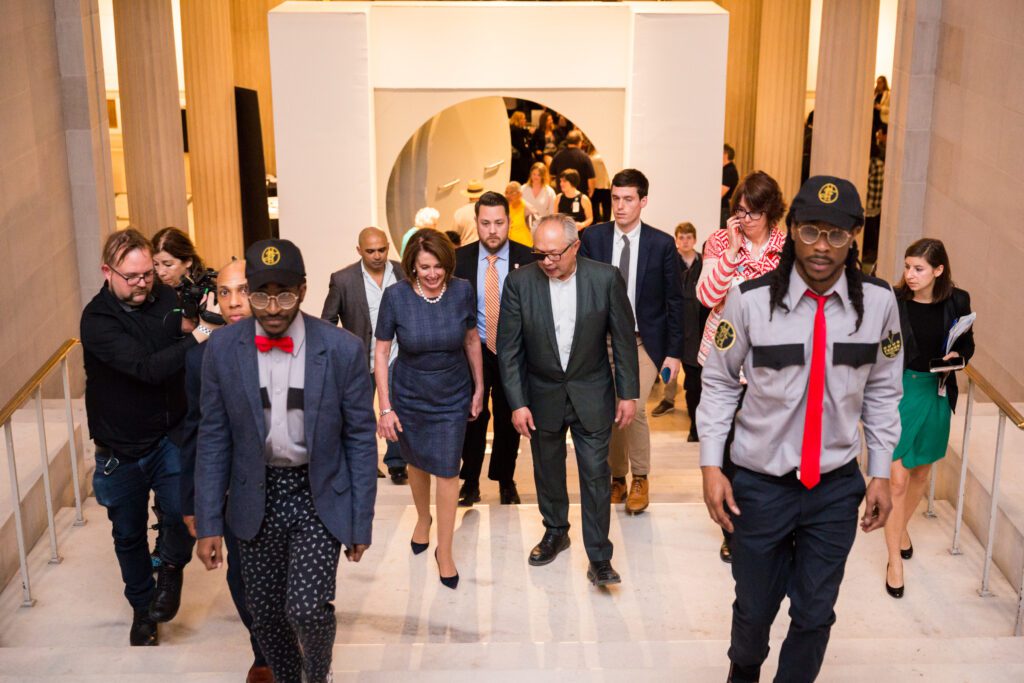Making change: Artist Mel Chin takes House Democratic Leader Nancy Pelosi to see the 2017 Fundred Reserve at the Corcoran School of the Arts and Design, part of Chin’s Fundred Project (2008-2019). (Photo credit: Yassine El Mansouri)
For MacArthur fellow Mel Chin, art is a powerful tool for addressing complex environmental issues.
By Rachel Gugelberger, Independent Media Institute
I began to grasp the breadth of Mel Chin’s work in 2015 when I included his video document “S.O.S. (Straight off the Street) Reloaded” in the first exhibition that I curated for the art organization No Longer Empty (NLE). Chin’s 2012 video document portrays Bronx residents with their messages to then-President Barack Obama scrolling across the screen to the sound of their respective heartbeats. A copy of this was sent to Obama.
In 2018, NLE partnered with the Queens Museum and produced a citywide exhibition of Chin’s work, which helped me understand his activist streak, especially relating to the environment. Spanning four decades of his career, the sprawling exhibition was a testament to the sheer magnitude of Chin’s curiosity. As an artist, he is tough to pin down. Hence, the 2018 exhibition title “Mel Chin: All Over the Place,” which tapped into the artist’s myriad interests, with newly commissioned projects that explored water rights, New York’s maritime history, and sea-level rise. And while he may have a “malleable and wide-ranging approach to [his] artistic practice,” being anchored to a particular “place” is something that informs much of his work; he responds to unique histories and characteristics.
In the work “Flint Fit,” for example, Chin worked with residents of Flint, Michigan, and Detroit/New York City-based fashion designer Tracy Reese to pilot an innovative economic system that simultaneously addressed the city’s water crisis, plastic pollution, recycling, and labor problems. This “prototype for action” transformed empty water bottles into a woven fabric that was sewn into clothing, ultimately providing new jobs for members of St. Luke NEW Life Center, a Flint-based organization that provides life skills, education, and workplace training. The first “Flint Fit” collection was unveiled at a fashion event at the Queens Museum.
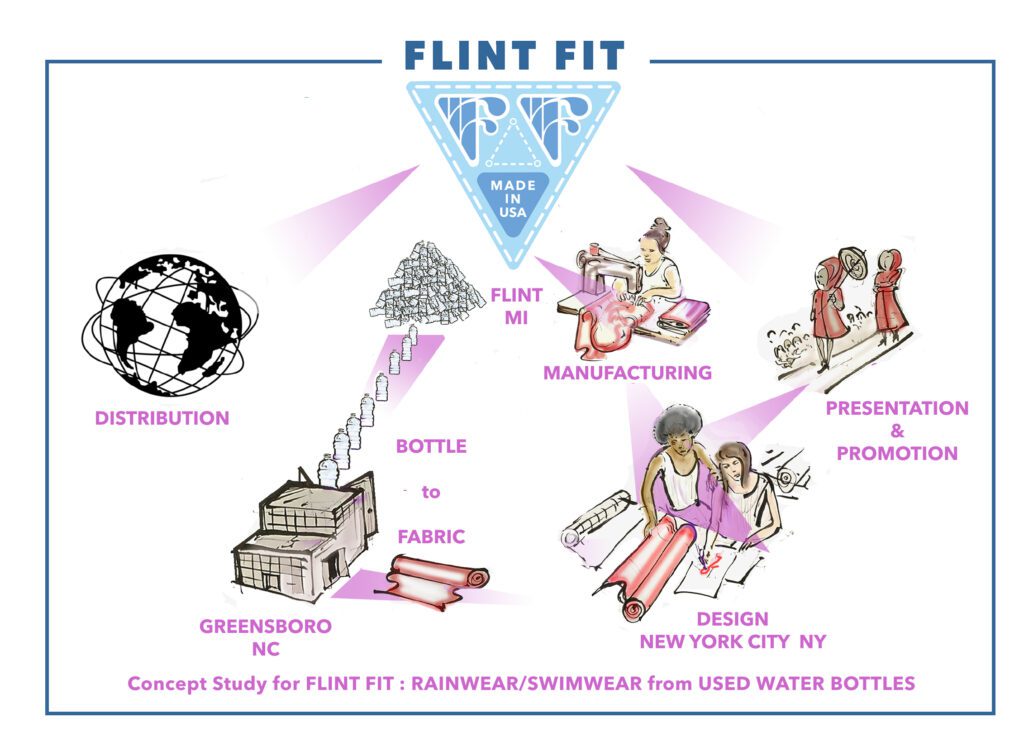
During a recent phone conversation, we touched on Chin’s “origin stories” and his collaborative, interdisciplinary art approach, how he consistently brings diverse groups of people together to transform ideas into action, and the power of art as a medium to achieve societal change: an effect of his work he is hesitant to claim. “Even the word ‘change’… that may be putting too much of a premium on this idea of art,” he tells me.
One thing is certain: Chin is interested in the process and the possibilities that may emerge from art. Like many of his works, “Flint Fit” is a concept, a prototype, a system. Its fundamental idea could be applied elsewhere, and perhaps be scaled to work on a regional, state, or federal level. A 2019 recipient of the MacArthur Fellowship (aka “genius grant”), Chin refers to his work as activism. But don’t call him an “activist artist,” a term he flatly rejects. He prefers “recovering conceptualist.”
Art, Activism, and Ideas
While the term “artivism”—a portmanteau of art and activism—is relatively new, the kinship between art and social responsibility or activism through art is not. In 2021, Social Movement Studies, a peer-reviewed academic journal, published an article by Stephen Duncombe and Silas Harrebye comparing “creative activism” to more conventional forms of activism. The authors of this research found that when it comes to raising awareness and inspiring engagement, a creative approach is much more effective than traditional advocacy methods. One of the partnering organizations for this research, the Center for Artistic Activism, meanwhile, points out that creativity alone isn’t enough to carry an activist message all the way through. “Training and organization… [are] key,” the organization states on its website. Chin emphasizes the role of empathy in promoting change: “Empathy must be used to increase the criticality necessary to launch into all the variables that are required.”
Chin does intensive research, talks to people in the communities where he produces work, and has a knack for deep listening. He collaborates and organizes. His cross-disciplinary practice often invites collective storytelling. “You listen to people,” he tells me, as he describes his collaborative process, which involves trial and error. “And then you apply your creative impulse and say, ‘Well, let’s try this.’”
Chin eschews the romanticized notion of the artist as an individual and as a sole creator of work; he is fueled by the energy and knowledge of others. Quick to downplay his own centrality, he prefers to call his work a “public practice” in which he acts as an artistic facilitator seeking co-creation with others. “The notion of the artist as the inventor or the creator in the public practice—that’s an impossible situation since it involves a connection with others,” he says. “The ego-driven [impulse] must be set aside if you want to have a collaboration… to be open to the creative impulses [that can be] regenerated in a more collective fashion.”
And while Chin is rooted in ideas—his far-ranging work has investigated philosophy, histories of landscape painting, multiculturalism, identity politics, global imperialism, inequality, and ecological issues—he’s all about the “thingliness” of things and choosing certain materials not only for their physical and formal characteristics but also for their symbolism and histories. “Vertical Palette” (1976-1985), for example, is a sculpture of five glass storage bottles containing materials that represent the Chinese Five Element Theory: water, wood, fire (smoke), earth (clay), and metal (lead). This work is a semantic nod to traditional Chinese painting and the painter’s tools that links the Chinese philosophy of life to the creative process.
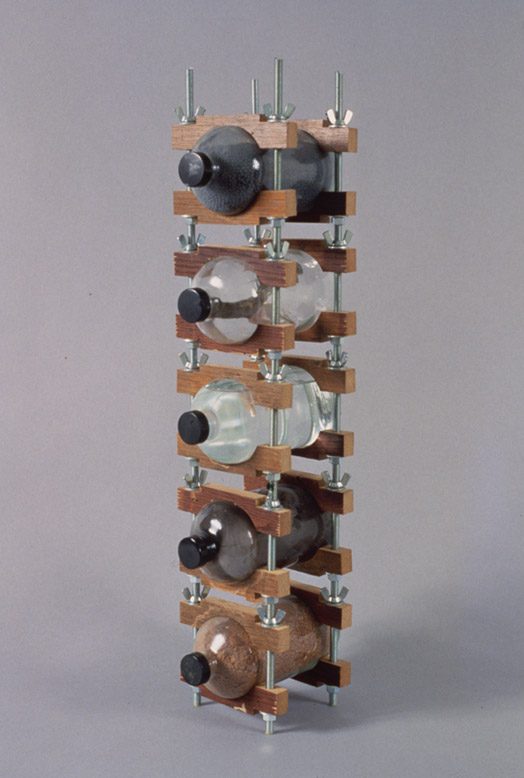
In the 1991 installation “Landscape,” Chin created mediated paintings of historical landscape traditions: a 13th-century scroll from China’s Yuan Dynasty, a 14th-century Persian miniature from Iran, and a 19th-century romantic American landscape. These paintings were installed one to a wall, with each wall constructed according to the topography of the 30th parallel along which China, Iran, and the United States all sit. And the three distinct landscape traditions were linked by locally sourced landfill soil (sanitized for museum requirements) seeping from the base of the walls. Uniting past philosophies of idealized nature with evidence of our waste and pollution, Chin showcased how distanced we are from our environmental impact. This approach to the physical elements and symbiotic cycles of destruction and renewal resurfaces in much of his work.
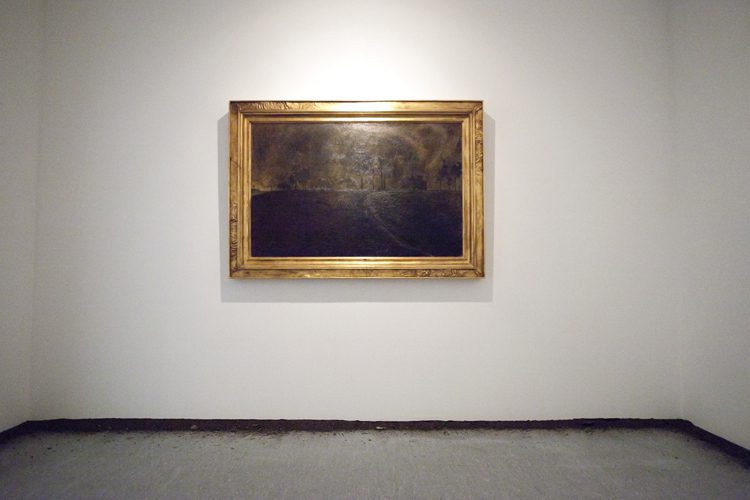
Tackling Childhood Lead Poisoning
Chin’s ongoing Fundred Dollar Bill Project highlights not only the power of tangibility of lived experiences and notions of value but also the fungibility of money. Launched in New Orleans in 2008, the project highlights a persistent yet often ignored environmental health problem, lead pollution. The project began in 2005; shortly after Hurricane Katrina caused widespread destruction, Chin went to New Orleans, joining other artists and cultural producers to imagine ways to respond to the devastation through artistic means. Feeling helpless in the face of the magnitude before him, he “was compelled to respond, and the only way to do so was to keep returning to [New Orleans to] learn [about] what needed to be made.” His research brought to the fore that long before the hurricane, “30 to 50 percent of the inner-city childhood population [had been] poisoned with lead.” A home that had been devastated by the floods caused by Hurricane Katrina was transformed into “Safehouse Temple Door,” which is a social sculpture that served as the project’s headquarters; a gathering place, workspace, and operable safe house, inviting “children, families and communities to imagine, express and actualize a future free of childhood lead poisoning,” states Mel Chin’s website. A steel and wooden bank vault was customized to replace the front door, making the safe house resemble a literal safe where valuables are stored.
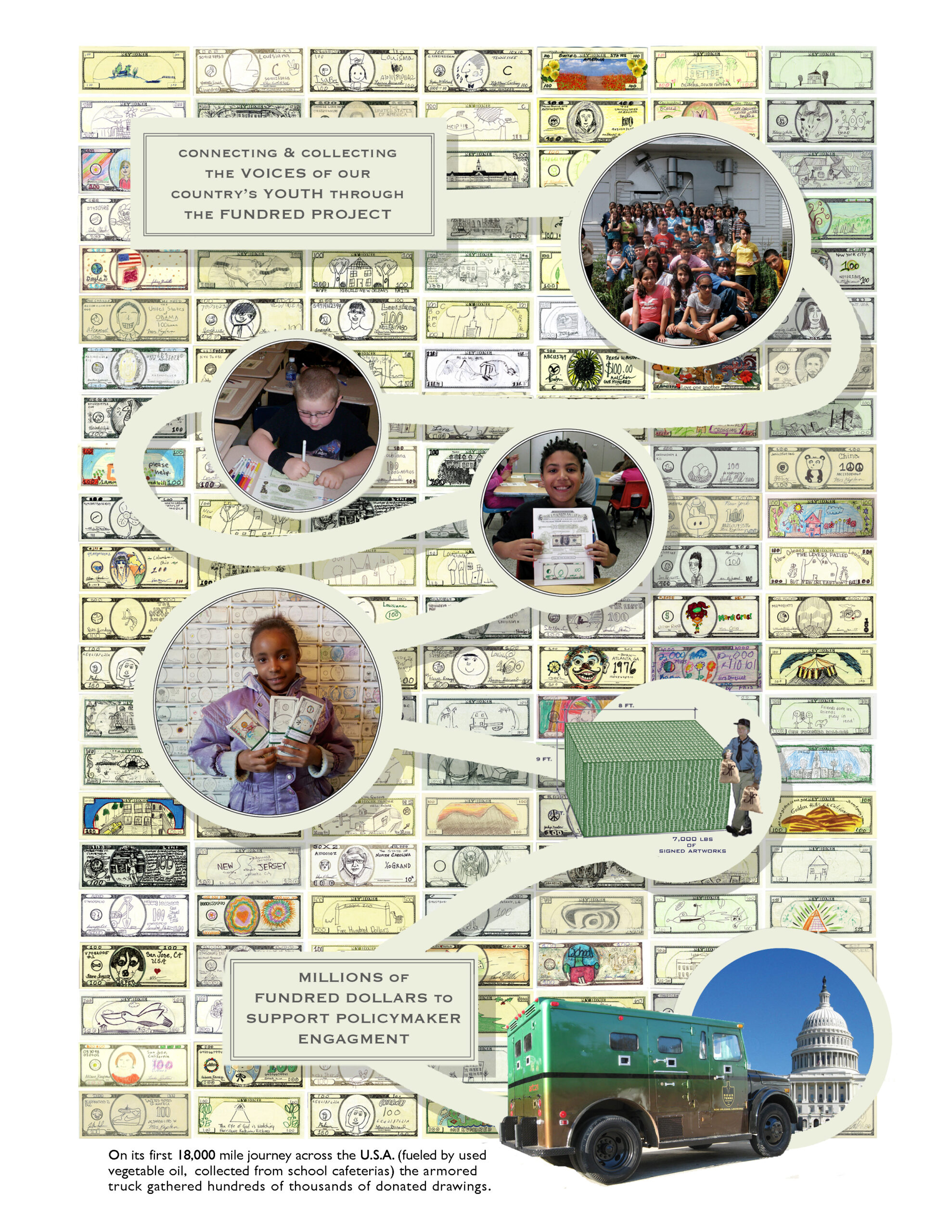
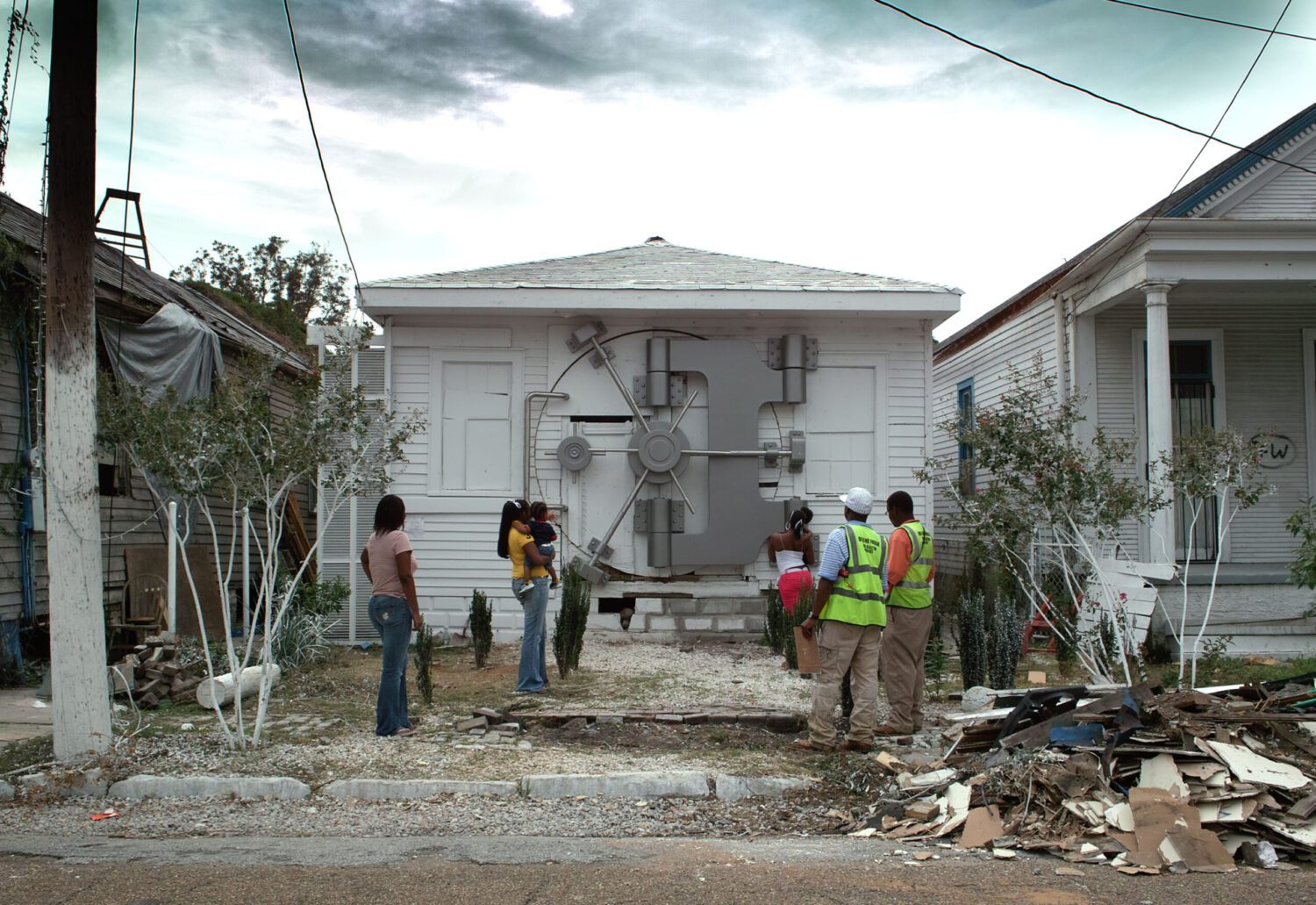
Lead enters the environment from paint, gasoline, and water pipes, affecting an estimated 37 million U.S. homes. While lead poisoning is difficult to detect, the symptoms for lead poisoning range from lethargy and reduced attention span to violent behavior and swelling of the brain; long-term effects may include brain and nervous system damage, convulsions, and death, according to the Fundred Project website. Populations most at risk from chronic lead poisoning in the U.S. include children between the ages of 1 and 3, people living in large metropolitan areas and in homes built before 1978, and children in low-income families and communities of color, underscoring pervasive issues of race and environmental justice.
On Chin’s website, “Fundred” is presented less as art and more as “a creative campaign advancing public education and community engagement”; community members, including children, are invited to create original, hand-drawn interpretations of $100 bills, or “Fundreds,” which represent the voices of people calling on those in power to address lead poisoning. “The goal,” Chin’s website says, “is to exchange the value of informed public voice into real resources to leverage 100 percent [lead] prevention.”
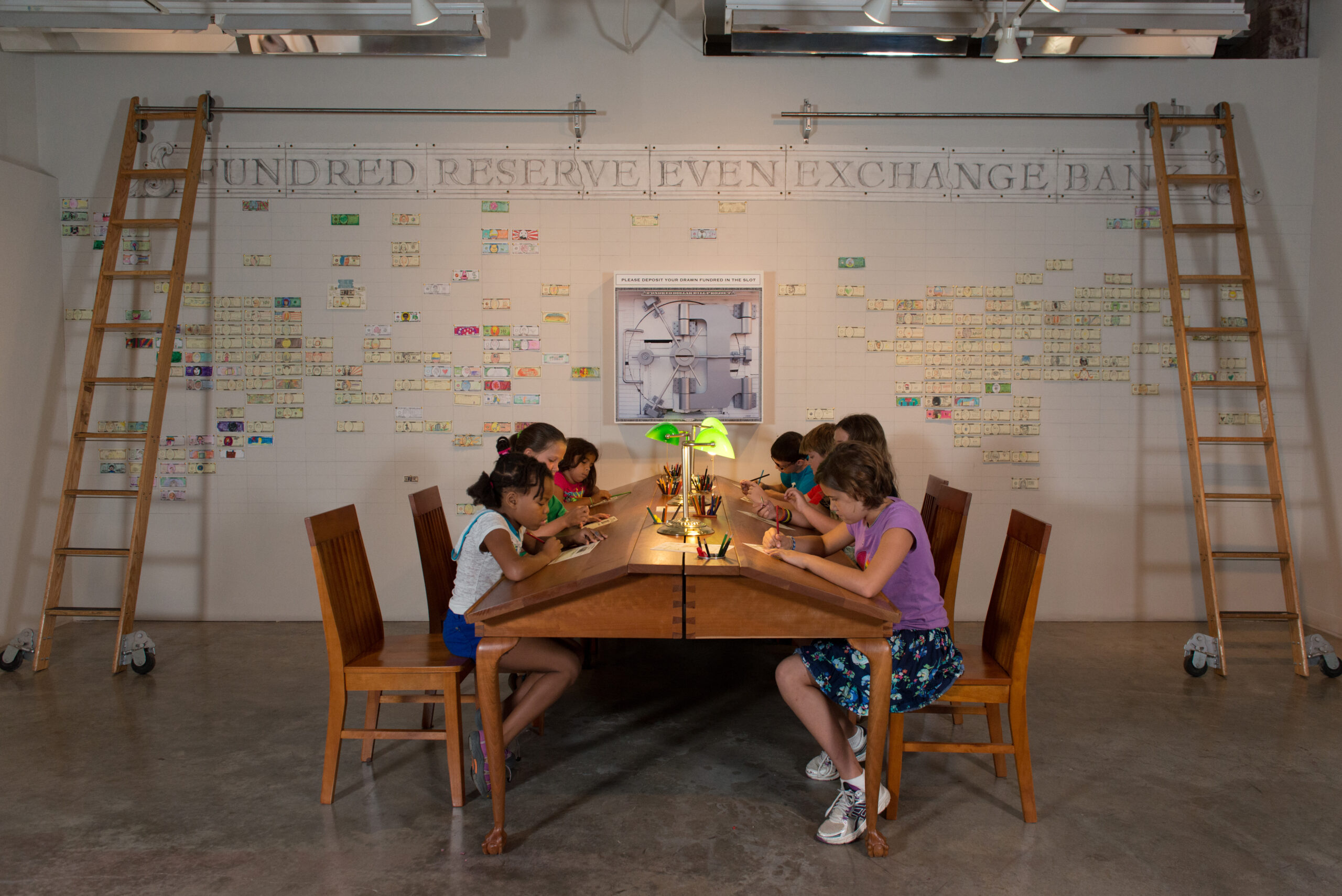
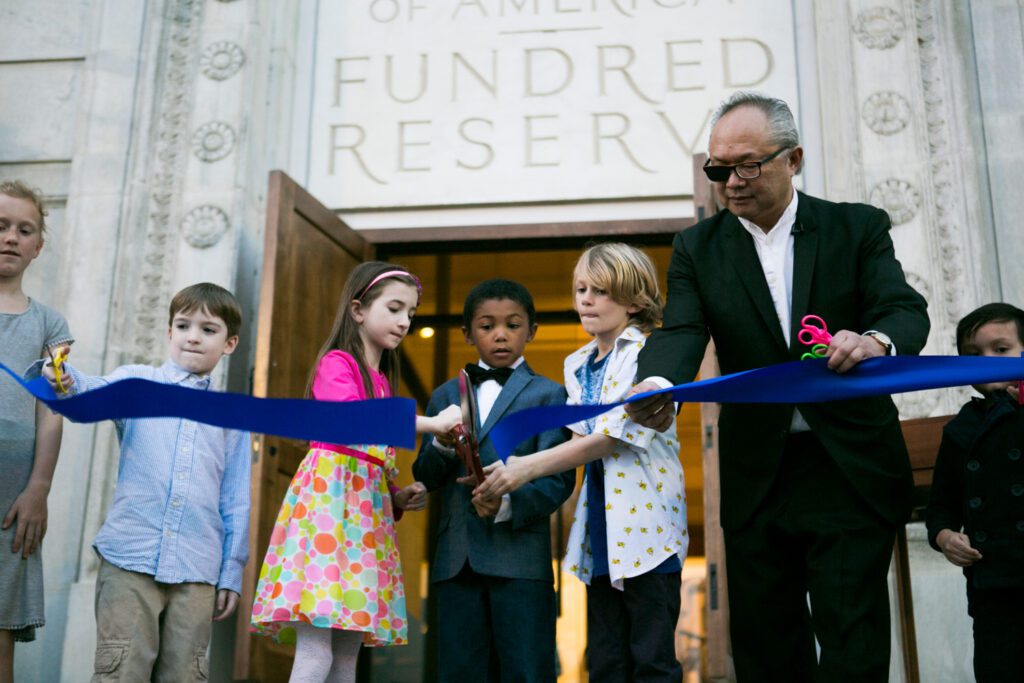
The scope of this creative, symbolic currency initiative has transformed the response to the ongoing lead crisis—and has even led to changing lead policies. In 2012, the Centers for Disease Control and Prevention’s funding for the Healthy Homes and Lead Poisoning Prevention Program was cut from $29 million to $2 million, and in 2015, the Flint water crisis shifted the way that “Fundred” operated: Roles changed and the Fundred Project’s network of participants, collaborators, and educators expanded to show that lead contamination isn’t just a problem for New Orleans but also an issue impacting communities across the nation. Students at schools across the U.S. have created thousands of “Fundreds” that were picked up in a specially designed armored truck and delivered in 2017 to the Corcoran School of the Arts and Design in Washington, D.C., to be exhibited, but more importantly, to amplify the voices of those affected by lead poisoning with policymakers and regulators. Efforts to place Fundred artists and their work before their congressional representatives and to advocate for more funding and lead-safe policies are ongoing.
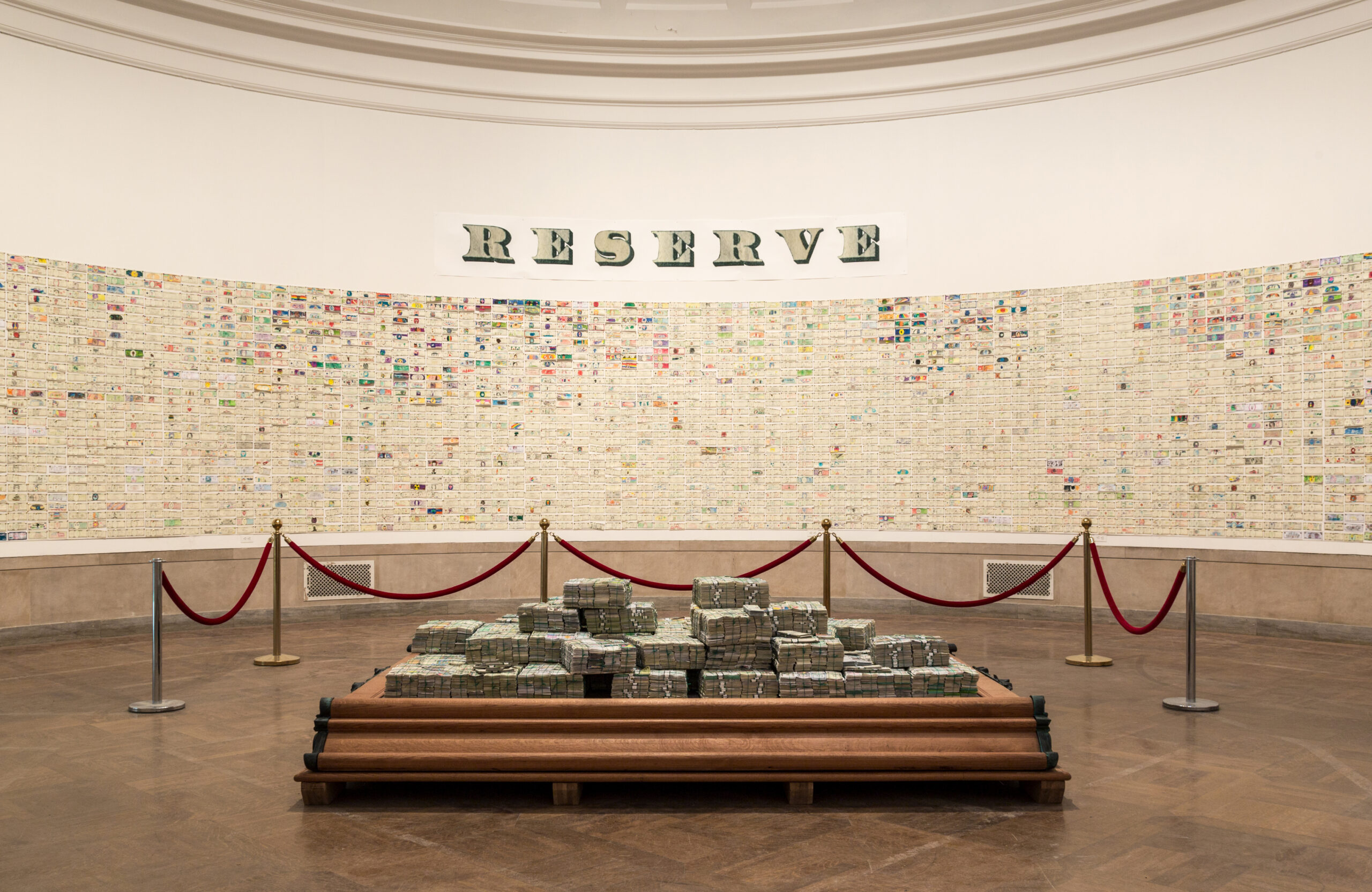
Climate Change: A Multifaceted Investigation
In 2018 as part of “All Over the Place,” Chin unveiled a different kind of creative campaign to highlight climate change with a two-part public “mixed reality experience” in New York City’s Times Square. One part, commissioned by the Times Square Arts, was the 60-foot-long installation “Wake.” A haunting, hulking, skeletal sculpture that evoked images of the hull of a sailing vessel and the skeleton of a whale, the installation was modeled after the USS Nightingale—whose own layered history spoke of conflict and change—and served as a fitting scaffold for Chin’s multifaceted investigation. The vessel upon which Chin’s “Wake” is based was launched as a “slave ship” in 1851. It was later captured by the U.S. Navy, serving as a Union supply ship during the American Civil War, and finally serving out its years as an Arctic research vessel. The title, “Wake,” suggests both what a ship, or indeed, humanity, might leave behind as it surges ever-forward, as well as represents the wake-up call that is required in order to prevent the worst consequences of man-made environmental damage and human rights violations.
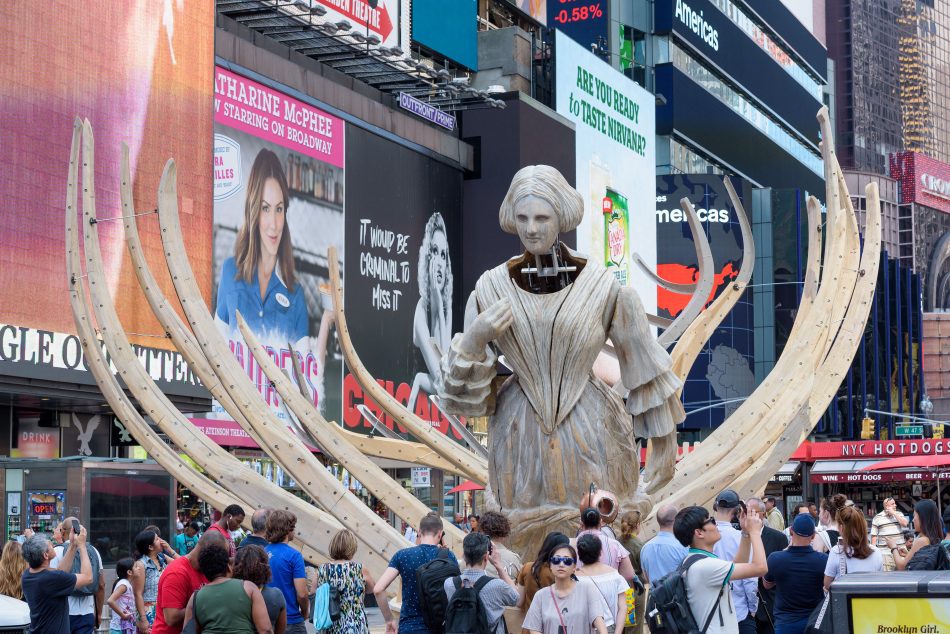
The other part of the installation, “Unmoored,” invited visitors to wear 3D goggles (or launch an augmented reality app on their mobile devices) to experience a vision of Times Square, submerged by the rising sea levels. An impressive technical feat, it also packed a wow factor by putting the possible underwater scenario of cities around the world like New York into clear, almost frightening, focus. New York is one of the nation’s most vulnerable cities to rising sea levels.
Like many of Chin’s works, the Times Square project conferred an urgency of action, almost demanding viewers—nearly 360,000 pedestrians who enter the heart of Times Square each day, pre-COVID—to stop, think, and listen to Mother Nature, amid the extreme capitalism on display. “I think the most important motivation as an artist is to use what James Baldwin has described as extracting the question that is buried within the answer,” said Chin, about “Wake.” “If the answer is, ‘The world will be inundated and destroyed by our own doings,’ then what is the question that we have to ask now?”
Origin Stories
Chin was born in 1951 in Houston to Chinese parents and was raised in a predominantly Black and Latino neighborhood. He experienced extreme mental stress around the age of 13 or 14 that left him catatonic and hospitalized for months, during which time he underwent shock therapy. Chin describes his mother’s will, unbridled care, and refusal to institutionalize him, combined with his father’s philosophical disciplines, as the remedy that gave him “the time to heal.” As he began to emerge from the fog of medications and regain ambulatory ability, he found that he had lost the capacity to draw; however, other sensitivities emerged that he says, “can drive the investigations of a lifetime.”
“I had the delusion that one day, I could be a fine artist,” says Chin, “a painter, sculptor, and all these things, all the trimmings of fine art.” Eventually, his interests became less about working with a particular medium and more about art’s “liberating aspect.” Perhaps that liberating aspect is generational. “My generation really did believe in transformative possibilities,” he tells me. But he also acknowledges that his generation was ultimately “unsuccessful based on the ecological, environmental, and societal record.”
When it comes to uncovering transformative moments to solve environmental problems, Chin has been trying to turn things around. In the early 1990s, he went to a Superfund site in St. Paul, Minnesota, called Pig’s Eye Landfill. There, he worked with Dr. Rufus Chaney, a senior research agronomist in the U.S. Department of Agriculture, to see if they could clean up soil that was contaminated by heavy metals left behind by industrial processes using “special hyperaccumulator plants.” It worked. One species of plant, in particular, Thlaspi (an edible herb also known as pennycress), demonstrated a knack for sucking cadmium out of the soil, drawing the chemical into its leaves and stems. A nasty byproduct of burning fossil fuels, cadmium is a major environmental contaminant and a Group 1 human carcinogen that, even with very little exposure, can potentially cause harm to virtually all of the body’s systems.
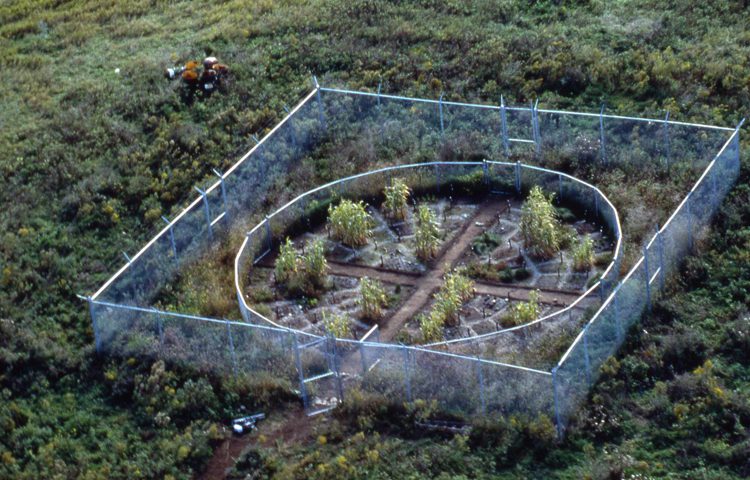
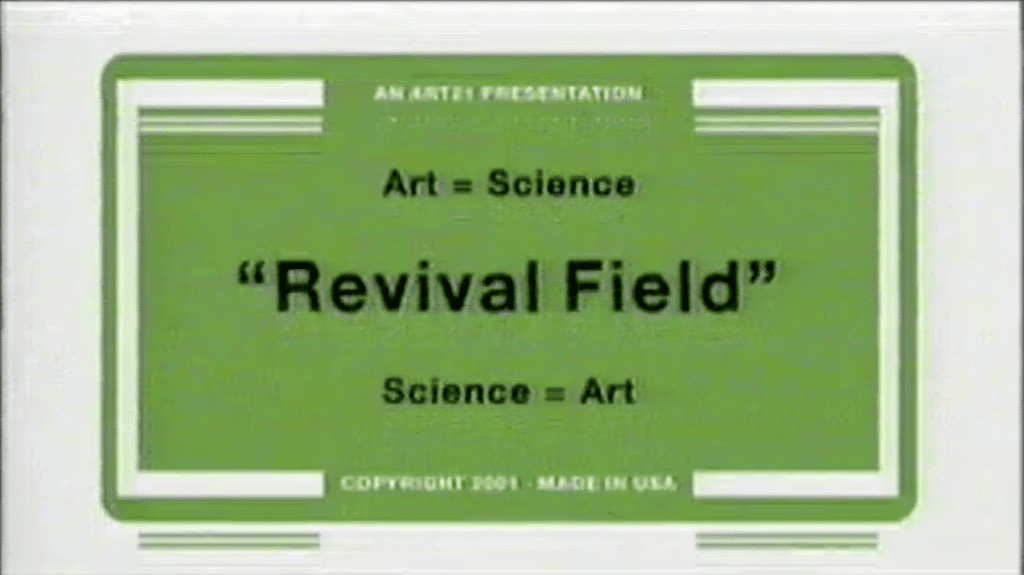
Green Remediation: Art Meets Science
The ongoing project “Revival Field” is a stark reminder that creative and natural solutions to persistent problems exist and can be replicated anywhere. Iterations have been developed in Palmerton, Pennsylvania (1993-1997), as well as in the Netherlands (1992) and Germany (2000-2001). And the project was ahead of its time; in 1998, several years after “Revival Field” was launched, the world’s greatest soil minds, gathered at the 16th World Congress of Soil Science, proposed that “phytoremediation using Thlaspi caerulescens would be entirely feasible for low levels of cadmium”—something that Chin and Chaney proved at Pig’s Eye Landfill seven years earlier.
While soil researchers and environmental advocates might look at “Revival Field” through the lens of science, Chin also sees the artistry behind both the process and the final piece. “We live in a world of pollution with heavy metals saturating the soil… If that [pollution] could be carved away, and life could return to that soil and then a diverse and ecologically balanced life, then that is a wonderful sculpture,” Chin said during an interview with Art21 about “Revival Field.”
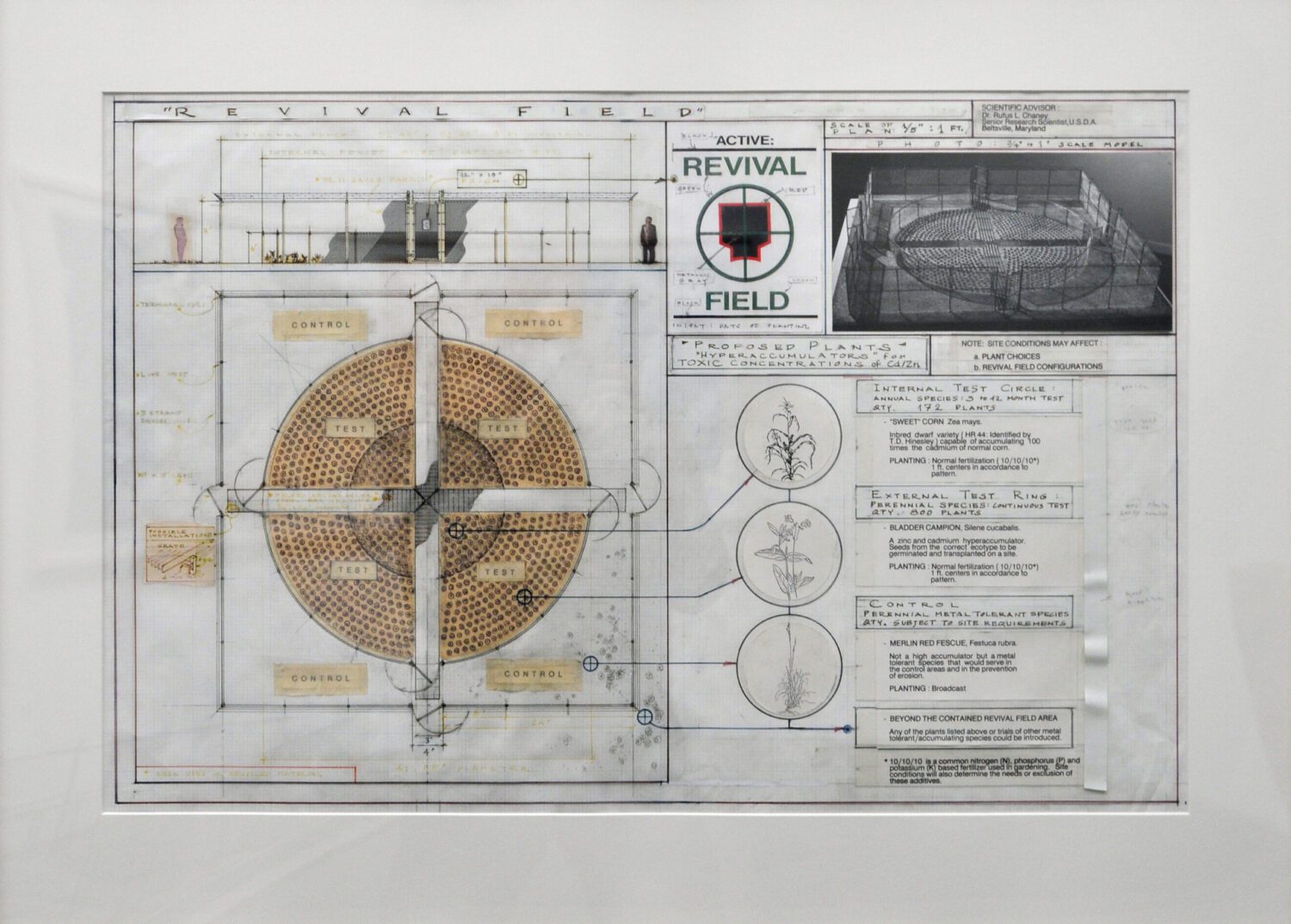
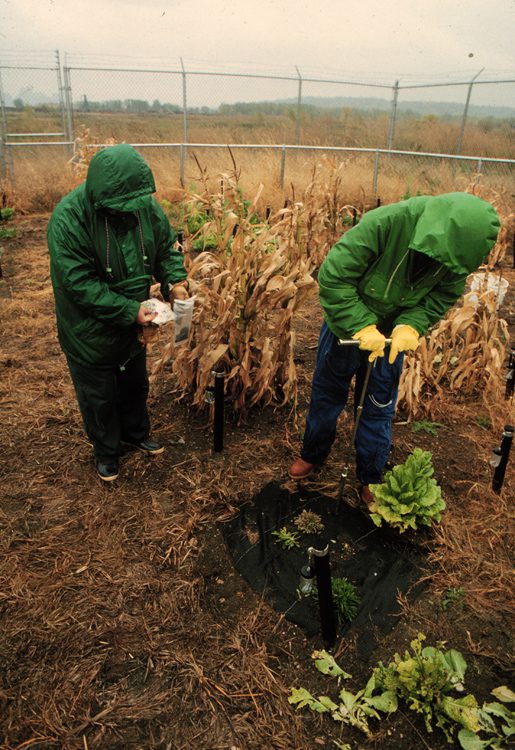
Profound, simple, and utterly natural, “Revival Field” stands in stark, yet graceful, contrast to more aggressive options of remediation, like using diggers and other heavy construction equipment to physically excavate the soil. Chin offers his solution both “as a conceptual artwork with the intent to sculpt a site’s ecology” and a “low-tech alternative to current costly and unsatisfactory remediation methods.”
A preeminent example of “eco-art,” “Revival Field” is acknowledged in USDA commentary as the scientific concept of “green remediation”—what the Environmental Protection Agency calls cleanup actions that “maximize net environmental benefit”—confirmed by an art project. “There haven’t been that many projects big enough or groundbreaking enough like ‘Revival Field’ and its peculiar nature, which were not object-based,” Chin says. And while Chin’s work is rooted in Conceptual Art and Earth Art movements, he moves beyond visual expressions to include the action of reversing environmental damage into the aesthetic.
Certainly, “Revival Field” isn’t an object. It’s a section of land despoiled by human industry that Chin has reclaimed. Chin’s work was produced at an auspicious time in the history of environmentalism. In 1989, a Gallup poll found that more than two-thirds of Americans called themselves environmentalists, a remarkable change from just two decades prior, before the Environmental Protection Agency, the Clean Water Act, and the Endangered Species Act were even born. In 1990, a year after Chin began the earthwork “Revival Field,” author, feminist, and social activist bell hooks wrote: “We must all decolonize our minds in Western culture to be able to think differently about nature, about the destruction humans cause” in Belonging: A Culture of Place.
“Chin says he has ‘always been messing with dirt,’” art critic Lucy Lippard observed in her exhibition catalogue essay for “Rematch.” Chin tells me that this association with dirt is actually rooted in clay, a fascination that began as an art student in a required class taught by his instructor Robert Freagon that he originally thought was “crass” but ended up being fertile soil for Chin’s imagination. He was soon knee-deep in everything relating to clay, from “erotic pottery from Peru to Yuan pottery in Japan… through clay, I learned about Zen,” Chin says.
In reclaiming a piece of land, quite literally, from the abuses of corporate greed (as in the case of “Revival Field”), there is a sense of “decolonizing” a place, of bringing it back to its former, unspoiled state. There’s a thematic, even lyrical, resonance between the semantics of decolonization and much of Chin’s creative approach; both are utopian and processual in nature. Where the decolonization process includes notions of “recovery,” Chin’s process includes “reclamation” and “revival.” Instead of “mourning,” Chin’s work “laments.” In place of “dreaming,” Chin “imagines.” And the daily “commitment” required of decolonization to change power dynamics is in Chin’s practice foiled in “ongoing community initiatives” and “action” that he manifests in modalities of “creative engagement toward policy change.”
Chin’s Constant Revolution
On the potential of art to enact social change, Chin says he is wary of “putting too much of a premium on this idea of art.” For Chin, it’s about the process, and, like so many of his works, it’s an ongoing affair, “a process of knowing.” Could this process of knowing help advance a transformational shift on a personal or even societal level? “We do have the capacity conceptually to provoke rapid evolution and mutation,” Chin says. “There’s a constant revolution.”
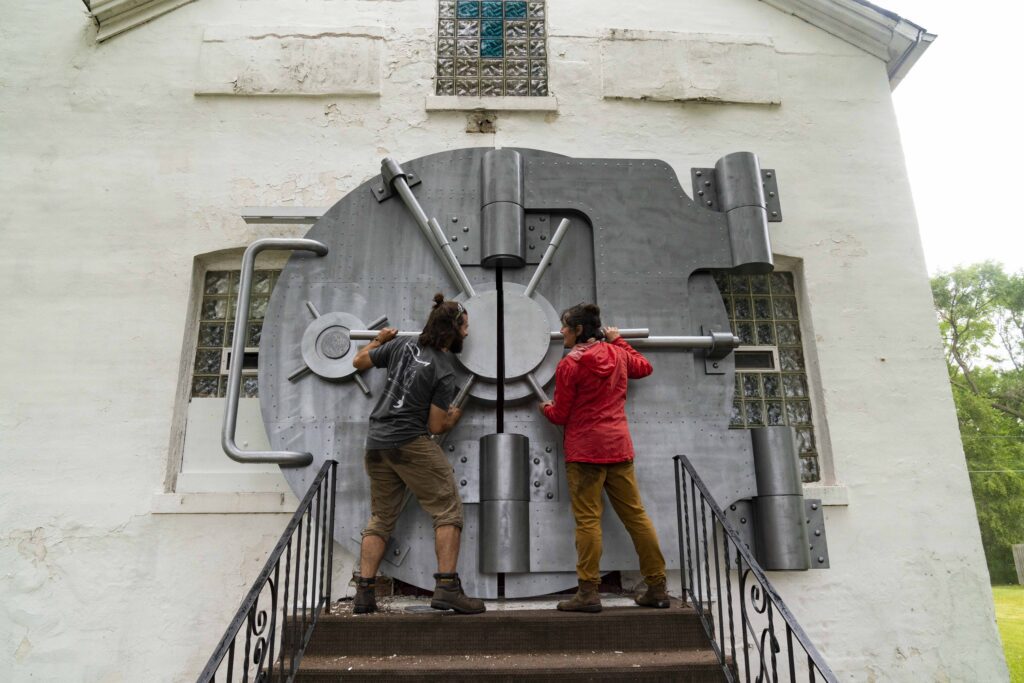
In 2021, the Smart Museum of Art at the University of Chicago presented the exhibition “Toward Common Cause: Art, Social Change, and the MacArthur Fellows Program at 40.” Organized in conjunction with the 40th anniversary of the MacArthur Fellows Program, the citywide exhibition was based on the “idea of ‘the commons’” and sought “to explore the current socio-political moment.” For Chin, it presented a perfect opportunity not only to continue the collaborative work of “Fundred” but also to expand the discussion of lead contamination to a wider national level. Underscoring his idea of a “constant revolution,” Chin engineered another iteration of the project, launching—in partnership with S.O.U.R.C.E. Studio, the Hyde Park Art Center, and Sweet Water Foundation—“Fundred Project Initiative: A Bill for IL.” Anyone who wanted to participate created Fundreds, which were collected for the Fundred Reserve, recently acquired by the Brooklyn Museum (where all Fundreds created through spring 2022 will be added). For Chin, it is yet another salvo of public voices calling for change. “This is one more step that we need to make,” Chin said. “It’s not done, is how I feel. It’s not done till the blood is clean of children being born in these places. That’s when it’s done.”
###
Author’s note: The work of Mel Chin and the Fundred Project can be seen across the United States. The Fundred Author’s note: The work of Mel Chin and the Fundred Project can be seen across the United States. The Fundred Reserve is on view in the Contemporary Art Collection at the Brooklyn Museum in New York, and “Safehouse Temple Door” is permanently installed at the Sweet Water Foundation in Chicago, Illinois. Fundred Lab is currently active at the Corvus Gallery at the University of Chicago, and the Fundred Project is on view at the Madison Museum of Contemporary Art in Wisconsin through March 20. The exhibition “Mel Chin: Points of View” is on view at the Five Points Museum of Contemporary Art in Texas, also through March 20, and “Inescapable Histories” is on view at the Gallery at the University of Texas at Arlington through March 30. Chin’s latest exhibition There’s Something Happening Here opens at the Madison Museum of Contemporary Art in Wisconsin on March 12. To learn more, visit S.O.U.R.C.E. Studio (Sustained Operations Utilizing Resources for Culture, Communities, and the Environment), an action-oriented arts and justice organization founded by Chin in 2017.The work of Mel Chin and the Fundred Project can be seen across the United States. The Fundred Reserve is on view in the Contemporary Art Collection at the Brooklyn Museum in New York, and “Safehouse Temple Door” is permanently installed at the Sweet Water Foundation in Chicago, Illinois. Fundred Lab is currently active at the Corvus Gallery at the University of Chicago, and the Fundred Project is on view at the Madison Museum of Contemporary Art in Wisconsin through March 20. The exhibition “Mel Chin: Points of View” is on view at the Five Points Museum of Contemporary Art in Texas, also through March 20, and “Inescapable Histories” is on view at the Gallery at the University of Texas at Arlington through March 30. Chin’s latest exhibition There’s Something Happening Here opens at the Madison Museum of Contemporary Art in Wisconsin on March 12. To learn more, visit S.O.U.R.C.E. Studio (Sustained Operations Utilizing Resources for Culture, Communities, and the Environment), an action-oriented arts and justice organization founded by Chin in 2017.
Rachel Raphaela Gugelberger is an editorial fellow with Earth | Food | Life (EFL) at the Independent Media Institute and the founding editor of EFL’s &Art project. In her more than two decades working in the arts, she has organized curatorial projects in the commercial, academic and nonprofit sectors with a focus on place-based practices and themes including history, women’s rights, social justice, activism, data, information science and the environment. Previously, she served as curator at No Longer Empty, which presented community-responsive exhibitions and education programs in unconventional spaces. She is currently a guest curator at Residency Unlimited in New York City.
A project of Earth | Food | Life, &Art highlights the work of creative problem solvers—artists, activist artists, cultural producers, and arts organizations—with a focus on the environment, agriculture, and nonhuman animal rights. Moving beyond representation and visual expression, &Art integrates art, environmentalism, food justice, and intersectional animal rights with examples of pragmatic approaches toward manifesting a more sustainable and just coexistence.
Click here to support the work of &Art and the Independent Media Institute.
Questions, comments, suggestions? Contact &Art editor Rachel Raphaela Gugelberger at [email protected] or EFL editor Reynard Loki at [email protected]. Follow EFL on Twitter @EarthFoodLife.
